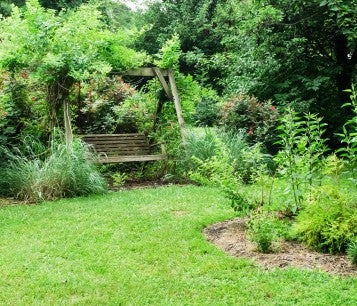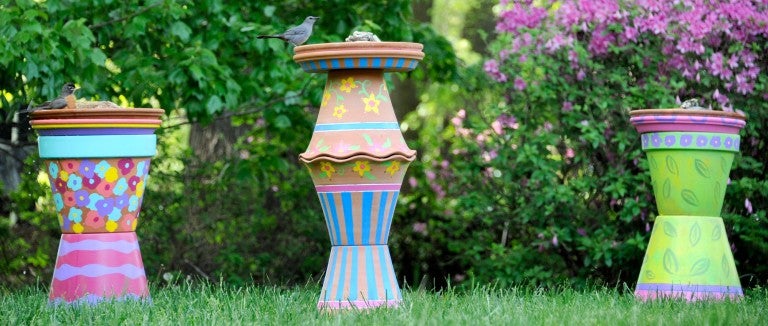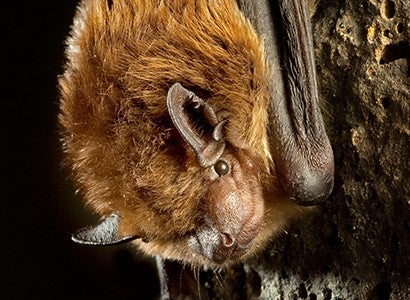As a new homeowner susceptible to sales pitches from the garden industrial complex, I spent my early planting years salivating over glossy magazine spreads exploding with color and texture and promises of endless summers.
“Flower porn” was how my husband described those lushly photographed publications filling my nightstand. He was right, although—it must be said—I also bought them for the articles.
In fact, everything I know about cultivated plants I learned from garden magazines. But they gave me an inadequacy complex. While their Top 10 lists doled out practical advice, the accompanying photos sent a different message: Buy the most eye-popping plants and birdbaths and trellises and shiny bobbles, and your life will be complete!
Having purchased two acres of dull lawn punctuated by one sad forsythia, I was drawn in by this manufactured sense of urgency, fixated on creating a picturesque haven to hide away with my thoughts and my dog. And I was willing to burn a hole in my pocket to do it, buying up the stock at local garden centers with abandon.
All that changed in 2005, when Hurricane Katrina washed away so much of the Gulf Coast and turned our HSUS headquarters into a disaster recovery center. As the weeks spent reuniting devastated pet owners with their animals turned into months, most other things in life began to seem trivial. I recall seeing a story about storm victims’ joy at watching sunflowers sprout from abandoned, muddy cars and other unlikely terrain. Against that backdrop, my efforts to mold my land in the image of some cultural fantasy felt extravagant and ridiculous. Compounding matters, I soon lost my dog, who’d toiled in the soil alongside me, to old age. Spending time in the garden seemed like a betrayal.
In short, I slowed down. I no longer cared how everything looked, even wondering whether I belonged there anymore. And, to my surprise, that’s when the magic happened. The more I let go, the more the land gave way to real grace. The volunteer sassafras, beloved by butterfly caterpillars, grew into a grove. Berry-laden Virginia creeper vines inched their way over fences and walls. Bare-root sumacs and dogwoods and redbuds and chokeberries, purchased for a dollar or two each, blossomed. Cardinals and doves and tiny songbirds I couldn’t identify began drinking from the homemade birdbath I’d thrown together from old pots after the expensive one crumbled apart. Butterflies congregated in the puddles in the driveway holes, so I began, as all crazy middle-aged ladies must, to water my driveway.
A humane backyard is a natural habitat offering wildlife plenty of food, water and cover, plus a safe place to live free from pesticides, chemicals, free-roaming pets, inhumane practices and other threats. And it's so easy to build!

Like cats who snub fancy toys in favor of paper bags and bottle caps, the wildlife in my yard made themselves at home without all the expensive trappings I’d once thought vital. This, I began to realize, was real paradise, and the animals seemed to agree. Since then, I’ve explored new ways to grow a backyard sanctuary on the cheap, the following included.
Pot it up
Making your own birdbath is as easy as stacking two flowerpots and adding a tray on top. You can paint the pots with outdoor paint from the craft store or keep them au naturel. Birds like neutral colors, so leave the inside of the tray unpainted. In the winter, when terra cotta can crack, a plastic lid works best.
Serve fast food
Using a drill bit or a hot glue gun, cut holes into an upside-down soda bottle (lid screwed on) or tennis ball container, insert dowels or wooden spoons for perches and twine for hanging, cut holes for feeding and fill with seed. For detailed instructions, search online for “tennis container bird feeders.”
Make a butterfly baby pool
As the red-spotted purples who visit my driveway puddles demonstrate, butterflies aren’t interested in larger watering holes that birds prefer. To create a butterfly mecca outside your driveway, fill a pie plate or platter with sand, put some twigs or pebbles on top for landing pads, add water to the level of the sand and place it near your butterfly garden.
Repurpose everything
You don’t need $80 cedar planks to build a raised bed or $10 bags of garden markers. I used old cinderblocks a neighbor no longer wanted to surround the perimeter, planting the holes with oregano and other favorites of bees and people. To mark native seeds you are growing for wildlife, pick up spoons at thrift stores and use a permanent marker or outdoor paint to label them.
Buy small
Native plants are the best source of food and shelter for wildlife, and if you buy small, they are also the cheapest. I purchase bare-root plants from companies like Musser Forests and state and local conservation programs. If your budget is small and you are patient, ignore the traditional advice to buy three to five of each species of perennials; natives often proliferate by taproot and seed, and many of my singletons have spawned hundreds of offspring over the years.
Give the bees shelter
Avoiding chemical products and planting natives helps create a refuge for bees.
The bats motel
By Ruthanne Johnson
Want more content like this?
This was written and produced by the team behind All Animals, our award-winning magazine. Each issue is packed with inspiring stories about how we are changing the world for animals together.
Learn MoreSubscribe

